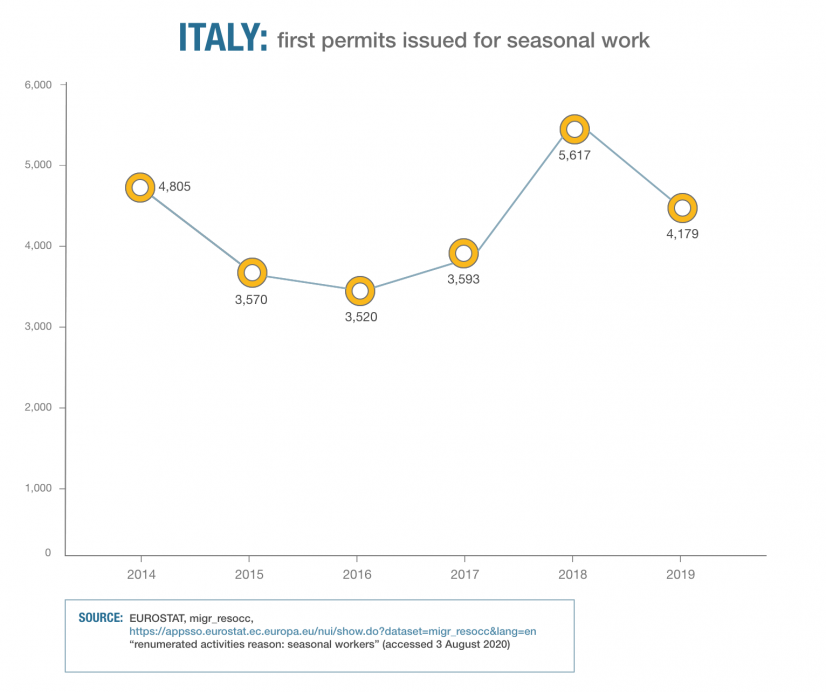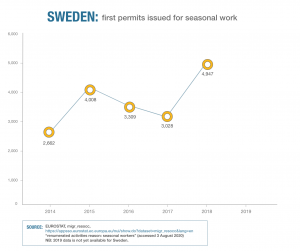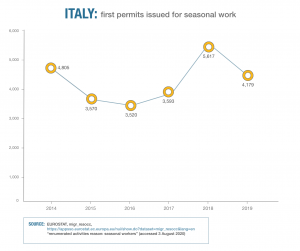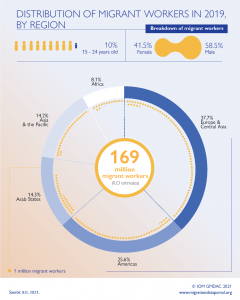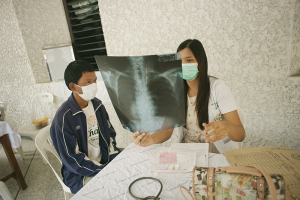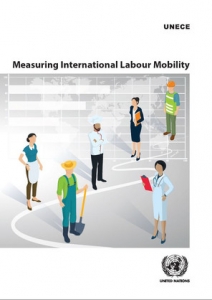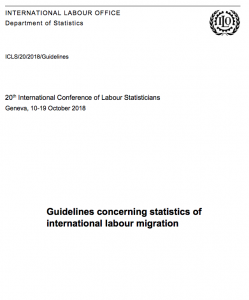Many of these occupations are classified as “low-skilled” (e.g. agricultural labour, food processing, care work). This classification reflects the type and years of formal education normally required for a job, but says nothing about the technical, physical and emotional capabilities necessary for certain types of work. These can be considerable, but are often acquired through work experience and on-the-job training rather than through education. It would be more accurate to define so-called “low-skilled jobs” by their level of remuneration and working conditions: Low-paid and precarious are the common denominators for many of these jobs. And migrants are often overrepresented in these sectors.
Undercounted: The case of seasonal migrant workers in the EU
Quantifying just how important particular categories of migrant workers are is not a straightforward task. Let’s look at migrant seasonal workers as one example. The EU agency for statistics (EUROSTAT) collects statistics on seasonal workers who migrate from non-EU countries (so-called “third countries”) to work in the EU. These statistics are based on the Seasonal Workers Directive (2014/36/EU), adopted in 2014, which harmonizes the rules for admission, residence and rights of seasonal workers. It defines a “seasonal worker” as a third-country national who has his or her main residence outside the EU and migrates to the EU legally and temporarily “for an activity dependent on the passing of the season”.
In a recent study, the Research Unit of the Expert Council of German Foundations on Integration and Migration and the Migration Policy Institute Europe asked what legal pathways are available for third-country nationals who wish to work in the EU and how these pathways are used in practice. Specifically, it examined migration opportunities in five EU countries (France, Germany, Italy, Spain and Sweden) for the “low-skilled”, including for seasonal work. As it turns out, however, the official EU statistics tend to undercount the number of seasonal workers.
Take the example of Italy: the EUROSTAT statistics for seasonal work (see figure below) belie the importance of the agricultural and tourism sectors in Italy, which rely on migrant workers, including seasonal labour. 370,000 migrant workers are employed in agriculture alone, representing 27 per cent of the legal agricultural workforce. Italy maintains bilateral agreements with countries outside the EU to organise seasonal migration. But the bulk of the low-skilled, low-paid seasonal work in Italy’s fields is carried out by people who are already in Italy but arrived via other pathways: for example, undocumented migrants or asylum seekers as well as EU citizens from eastern Europe. In other words, the official channels to hire seasonal workers are vastly underutilized and the quotas set in bilateral agreements are inadequate to meet demand. The recently announced regularisation of undocumented workers in Italy is testimony to the fact that much of Italy’s seasonal work occurs outside legal channels.
In Sweden, approximately 3,000 to 5,000 migrant workers, mostly from Thailand, enter the country every year through a special work permit for “berry pickers and planters”. These numbers by the Swedish Migration Agency match the EUROSTAT figures. However, the statistics again undercount the true number of berry pickers and other seasonal workers in Sweden: The special work permit only applies to those seasonal workers recruited by Swedish companies, while in reality most berry pickers are employed by placement agencies in Thailand. In addition, Sweden also receives seasonal workers from within the EU who are not included in the national or the EU statistic. Notably, Sweden also made an exception for seasonal agricultural workers to enter Sweden despite the travel bans linked to the pandemic. But as air travel effectively ground to a halt, workers from third countries – such as Thailand – were unable to travel to Sweden.
Germany, by contrast, does not appear in the EUROSTAT statistics at all. The reason is not that Germany does not need seasonal workers – quite the contrary: Such were the needs of the agricultural sector that the German government, too, created an exception to the pandemic-induced travel restrictions. In April and May 2020, approximately 40,000 seasonal workers – mainly from Romania – entered Germany on special charter flights to pick fruit and vegetables, only half of the government-set quota of 80,000 for the two months. Prior to COVID-19, Germany received approximately 300,000 seasonal workers per year for agricultural, horticultural and forestry work. Germany does not appear in the EUROSTAT statistics because it relies on migrants from other EU Member States, especially in Central and Eastern Europe
Undervalued and underprotected
Why is this relevant? As they say: “Only what is counted, counts”. Without improving the statistical evidence base it is difficult to gauge the true scale of – and hence demand for – seasonal workers across Europe. This in turn reduces the policy incentives to create adequate legal pathways for “low-skilled” migrant workers, including seasonal workers. At the level of the EU and of Member States, statistical offices should build a more complete data picture of intra-EU seasonal migration and harmonise data that may be collected by different ministries, such as those in charge of migration, agriculture or labour. Where recruitment agencies are involved in the matching of seasonal workers to destination countries, they too, could provide insights and data on broad trends. Other data sources can help create a more meaningful assessment of the scale of (seasonal and non-seasonal) foreign labour in individual sectors, such as agriculture: The Organisation for Economic Co-operation and Development (OECD), for instance, provides data on foreign-born workers who made up 9.6 percent of Germany’s skilled agricultural, forestry and fishery workers and 11 percent in Italy in 2015/16. But on their own, these sources represent a partial picture, at best, and one that is reliant on the accuracy of national statistics.
The lack of data also hampers planning and investment in adjacent policy fields, especially social and labour protection in sectors prone to abuse and exploitation. The risks for seasonal workers are well documented and result from a combination of social and geographical isolation, precarious contracts and the harsh working conditions that come with the job. In Germany, for instance, many seasonal workers do not have health insurance. COVID-19 has heightened the problem, as could be seen across Europe when a disregard for social distancing and hygiene measures in the housing and working conditions for seasonal migrant workers led to outbreaks and even the death of seasonal workers.
There is also a larger policy picture: We need to have a better grasp of how significant low-paid, “low-skilled” work is in our economies – and how much of it is done by migrants. Hopes that native workers would step up to take on strenuous agricultural labour during the pandemic, for example, were largely disappointed. Moreover, while countries such as Germany rely on intra-EU mobility, demographic and economic trends in key origin countries indicate that the pool of workers willing to migrate to Germany for seasonal work will soon no longer suffice to meet demand. Countries such as Italy should consider the costs of depending on undocumented migrants already in the country, in terms of rights violations, the public health risks linked to a precarious and undocumented workforce during a pandemic, but also the potential underemployment of individuals in this population who may have skills to do other jobs. This should ideally lead to a higher appreciation and protection of such workers, but also to the opening of adequate safe and legal channels, rather than leaving it to informal and illegal mechanisms and actors to match demand and supply.
This article is based on the results of a joint research project by the Research Unit of the Expert Council of German Foundations on Integration and Migration (SVR) and the Migration Policy Institute Europe (MPIE): “Legal migration for work and training: mobility options to Europe for those not in need of protection”. The project was funded by Stiftung Mercator.


